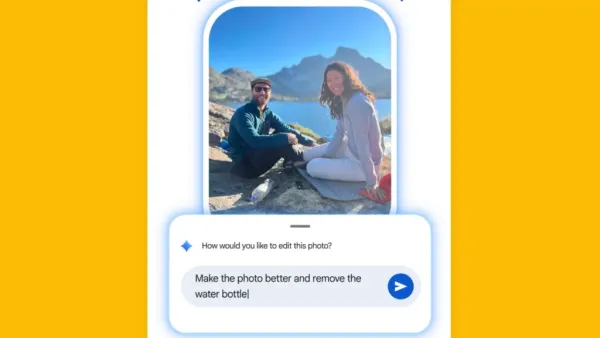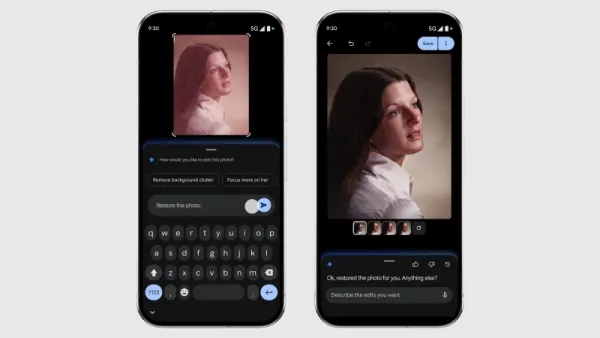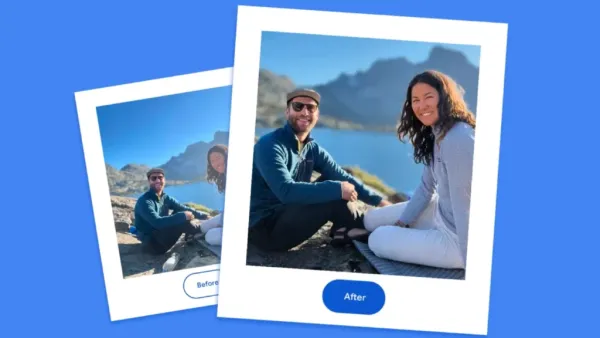
On August 20, 2025, Google announced one of the most significant improvements to Google Photos, which fundamentally altered the editing of images for users. For years, editing photos meant moving sliders, adjusting brightness, or learning complicated tools. Now, aided by the Gemini-powered conversational AI, users can ask Google Photos AI to edit images simply by articulating what is required. In doing so, the reintegration of this technology joins AI, creativity, and transparency to fundamentally alter how people interact with their photo libraries.
Editing With Words, Not Tools
The star feature in this Google Photos AI update allows one to perform editing by describing the action. Instead of applying filters and looking through settings: “Remove the cars in the background”, “Fix the washed-out colors”, “Restore this old photo”. The AI goes ahead and interprets the editing request and carries out the required adjustments automatically.
This concept reverses a classical approach that considered editing software as tools and places interest into the final design of the result-or what editing intends to get out. Even more potent is the ability to layer instructions. First, the user would say, “Remove reflections in the glass,” after which they say, “Make the sky brighter and increase the contrast.” The conversation continues to build upon itself so that they feel like natural dialogues rather than an engineering procedure.

Beyond Fixes: Creativity Unlocked
Google Photos AI editing goes beyond simple corrective fixes and allows you to wield imaginative changes. Users can then request backgrounds changed for their photos, places of interest added, like sunglasses, or even party hats for the people in the frame. This makes the tool not only a means to correct imperfections but also a way to express creativity, personalization, and fun. In the process, things that once defined professional editing software and everyday casual use blur. Things that were formerly reserved for designers armed with Photoshop or Lightroom are now available to anyone with a camera on their phone.
Transparency Through Content Credentials
Alongside these editing tools, Google has made a priority of transparency and authenticity. With the age of AI-generated and AI-altered content coming in, users have naturally started wanting to know whether a given photo is an original or has been touched up, entirely, and heavily modified. Google Photos AI thus supports C2PA Content Credentials. These credentials provide a visible record of how an image was created and processed, whether by AI editing tools or otherwise.
Directly viewable from the app, they present editing details, provenance- information, and other metadata. By collaborating with standards such as IPTC metadata and Google DeepMind’s SynthID watermarking, Google is attempting to set an industry standard for digital trust. This transparency protects viewers from deception in a world in which altered images could otherwise be immediately unleashed to spread misinformation, and in turn, help maintain credibility for photographers, creators, and journalists.
Accessibility and Rollout
Pixel 10 users in the U.S. shall become the first ones to try out the conversational AI editing feature, in keeping with Google’s tradition of minimizing new Photos features to its flagship devices for testing purposes. A global rollout to Android and iOS devices will happen in the following weeks to attain accessibility. The staggered launch appears to be a calculated move: It would allow the company to collect feedback from early adopters, create the necessary refinements to the tool, and guarantee its global stability before serving millions of users.

Shaping the Future of Photo Editing
The new editing experience is part of a broader trend in technology, in which AI is being integrated into the tools we use every day. Just as predictive text changed how we write and smart assistants changed how we search, conversational editing could become the standard way people engage with their media.
Naturally, the shift raises important questions. How will professional editors react when everyday people are creating near-professional work? Will AI editing create images that are more “perfect”, but less real, in our everyday lives? And how will users manage the excitement of a creative alteration with the accountability of at least letting the audience know that they have adjusted an image? Google’s addition of transparency credentials suggests the organization foresees these challenges and wants to build trust while allowing creativity.
Summary
Google Photos’ new AI editing tools represent a huge step up in both usability and accessibility. By enabling users to describe the adjustments they want, in natural language, Google is democratizing photo editing and making it even easier to use.
The introduction of content credentials also highlights a recognition that, in the age of AI, trust and authenticity are just as important as creative capabilities. As the feature goes beyond Pixel 10 to apps on Android and iOS, millions of users will soon be able to engage with their memories in a completely new way – as a process not of mastering tools, but expressing intention. Essentially, Google Photos is conceptualizing editing not as a skill, but as a conversation.
-
‘Arif Khan will give kidney to Premanand Maharaj’ … Muslim man offered, said- society needs a saint like you

-
Chanakya Policy: Never tell the enemy these 3 things, otherwise life can be ruined!

-
MCA unveils legendary cricketer Sunil Gavaskar’s statue at Wankhede stadium

-
Viktor Gyokeres, Jurrien Timber bag braces as Arsenal hammer Leeds United 5-0 in Premier League

-
In 140 countries traveling, 400 cities and 3 years in a luxurious villa on the sea; What is ‘this’ Golden Passport Plan?
